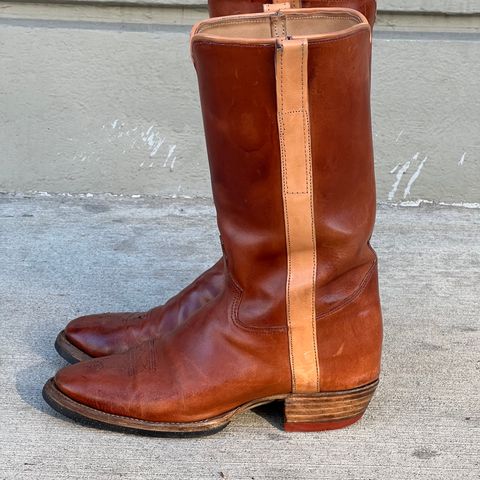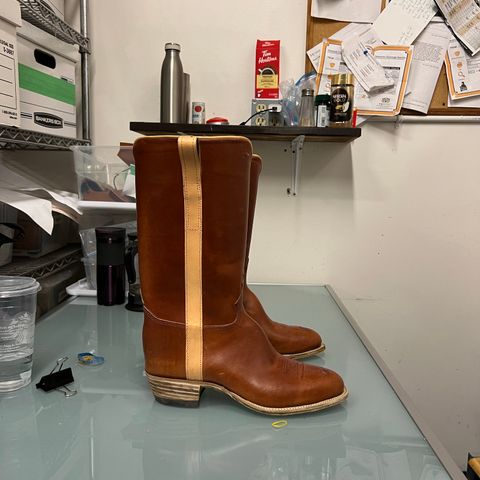About
Cognac is a rich brown color variation of Maremma leather, a 100 percent vegetable-tanned leather produced by Conceria Puccini Attilio in Tuscany. This warm, medium-brown tone represents one of the classic colors in vegetable-tanned leather, offering versatile appearance suitable for leather goods, footwear, and accessories while developing characteristic patina through use.
About
Cognac is a rich brown color variation of Maremma leather, a 100 percent vegetable-tanned leather produced by Conceria Puccini Attilio in Tuscany. This warm, medium-brown tone represents one of the classic colors in vegetable-tanned leather, offering versatile appearance suitable for leather goods, footwear, and accessories while developing characteristic patina through use.
The cognac designation references the rich amber-brown tones reminiscent of aged cognac spirits. Applied to Maremma's full-grain double shoulder construction, this color provides initial visual warmth that deepens and enriches through exposure to light, handling, and wear. The vegetable tanning foundation allows natural color evolution that distinguishes genuine Tuscan leather from synthetically colored alternatives.
Characteristics
Color and Appearance
Cognac Maremma presents medium-brown tones with warm amber undertones when new. The color depth varies naturally across each hide, reflecting the full-grain surface's retention of natural characteristics and grain patterns. The smooth grain finish allows the cognac color to display evenly while permitting subtle variation that contributes to visual interest.
Unlike heavily pigmented leathers, cognac Maremma's color penetrates through the hide structure via vegetable tanning rather than surface coating. This through-colored construction means wear and use enhance rather than diminish the color presentation, as the underlying leather shares the same amber-brown tones as the surface.
Material Properties
Cognac Maremma maintains the firm temper and structural characteristics of the Maremma leather type. The vegetable tanning using chestnut, mimosa, and quebracho extracts provides durability and natural flexibility. The full-grain construction preserves tactile variation and natural grain structure, distinguishing each hide's unique surface character.
The leather breathes naturally due to the vegetable tanning process, which does not seal the fiber structure as chrome tanning does. This breathability contributes to comfort in footwear applications and prevents moisture accumulation in leather goods construction. The natural tannins provide inherent resistance to biological degradation while maintaining environmental compatibility.
Color Development and Patina
Initial Presentation
New cognac Maremma displays consistent medium-brown tones with subtle natural variation. The smooth grain finish provides professional appearance suitable for refined leather goods and footwear. The color presents warm character without excessive brightness, offering versatile aesthetic that complements various design contexts.
Aging Progression
Vegetable-tanned leather develops rich patina through exposure and use. Cognac Maremma deepens and enriches over time, with high-contact areas darkening more prominently than protected surfaces. This differential aging creates visual depth that reflects each piece's use history and care regimen.
Light exposure contributes significantly to color development in vegetable-tanned leather. Cognac tones may warm toward reddish-brown or deepen toward chocolate-brown depending on UV exposure and handling oils. This natural evolution represents a key characteristic valued in authentic Tuscan leather.
Comparison with Other Colors
Cognac offers medium-brown tones that balance between lighter tan shades and darker brown variations. This positioning provides versatile appearance suitable for both professional and casual contexts. The warm undertones distinguish cognac from cooler brown tones or neutral tans, offering distinctive character while maintaining broad compatibility with different styles and applications.
Production
Tanning Process
Cognac Maremma undergoes the same vegetable tanning process employed for all Maremma production. Natural tannins from chestnut, mimosa, and quebracho trees penetrate the double shoulder hides during extended processing in wooden drums with pure water. The cognac color results from specific dye selection applied during or after the tanning process, integrated with the vegetable tannin structure.[1]
The color application follows traditional methods that ensure even penetration through the leather substance. Unlike surface dyeing that creates shallow color layers, the vegetable tanning process allows color integration throughout the hide thickness. This through-coloring contributes to the leather's aging characteristics and patina development.
Finishing
The finishing process includes custom fatliquor application using natural oils, providing suppleness and enhancing color richness. Manual finishing techniques such as polishing with felt and amber stone develop the smooth grain surface characteristic of Maremma leather. These traditional methods preserve the cognac color's natural warmth while providing subtle surface protection.[1]
Slow drying methods complete the production cycle, allowing the leather to stabilize without stress that could affect color uniformity or structural integrity. The minimal surface pigment correction philosophy maintains the cognac color's natural character and transparency, distinguishing Puccini Attilio leather from heavily finished alternatives.
Applications
Leather Goods
Cognac Maremma's warm brown tones make it particularly suitable for leather goods where professional appearance and patina development are priorities. The color provides versatility for bags, luggage, wallets, and accessories, complementing both traditional and contemporary designs. The vegetable-tanned foundation ensures compatibility with traditional leather goods construction methods.
Footwear
In footwear applications, cognac Maremma offers classic brown tones suitable for both formal and casual styles. The color works effectively in boots, dress shoes, and casual footwear where vegetable-tanned leather's characteristics contribute to long-term performance and appearance. The firm temper supports traditional lasting methods while the natural tannins facilitate the leather's conforming to the wearer's foot through use.
Other Applications
Cognac Maremma serves effectively in belt construction, furniture upholstery, and various leather craft applications. The warm color tones and patina development make it appealing for visible applications where leather aging contributes to aesthetic value. The smooth grain and consistent color presentation facilitate quality construction across multiple contexts.
Care and Maintenance
Conditioning
Regular conditioning maintains cognac Maremma's suppleness and enhances color richness. Apply quality leather conditioner or natural oils sparingly, working the product into the leather surface with soft cloth or fingers. The conditioning process deepens the cognac tones temporarily while providing long-term protection against drying and cracking.
Frequency of conditioning depends on use intensity and environmental conditions. Leather goods experiencing frequent handling benefit from quarterly conditioning, while storage pieces require less frequent maintenance. Avoid over-conditioning, which can darken the cognac color excessively or create greasy surface texture.
Cleaning
Clean cognac Maremma with slightly damp cloth to remove surface dirt and debris. For deeper cleaning, use saddle soap or leather cleaner specifically formulated for vegetable-tanned leather. Test cleaning products on inconspicuous areas first, as some cleaners may affect the cognac color or finish. Allow cleaned leather to dry naturally away from direct heat sources, which could cause uneven color changes.
Patina Enhancement
The cognac color's natural patina development can be enhanced through deliberate care practices. Regular handling and use contribute oils and subtle wear that deepen color richness. Some leather enthusiasts apply natural oils or conditioners to accelerate patina development, though this approach risks over-darkening if applied too liberally.
Light exposure affects cognac vegetable-tanned leather significantly. Positioning leather goods near windows or in bright environments accelerates color development, while storage in dark conditions preserves the initial color tones. Understanding these effects allows intentional patina management based on aesthetic preferences.
Why Choose Cognac Maremma?
Cognac Maremma combines the classic appeal of warm brown leather with authentic Tuscan vegetable tanning methods. The color provides versatile aesthetic suitable for diverse applications while ensuring distinctive patina development through use. The vegetable tanning foundation offers environmental benefits and traditional craftsmanship verified through Puccini Attilio's membership in The Genuine Italian Vegetable Tanned Leather Consortium.
For projects prioritizing natural materials, sustainable production, and leather that improves with age, cognac Maremma delivers documented quality from a family-operated tannery with four generations of expertise. The cognac color specifically offers warmth and character that enhances as the leather develops patina reflective of individual use and care.
References
"About us". Conceria Puccini Attilio. Retrieved October 29, 2025.
"Puccini Attilio". Consorzio Vera Pelle Italiana Conciata Al Vegetale. Retrieved October 29, 2025.


































































